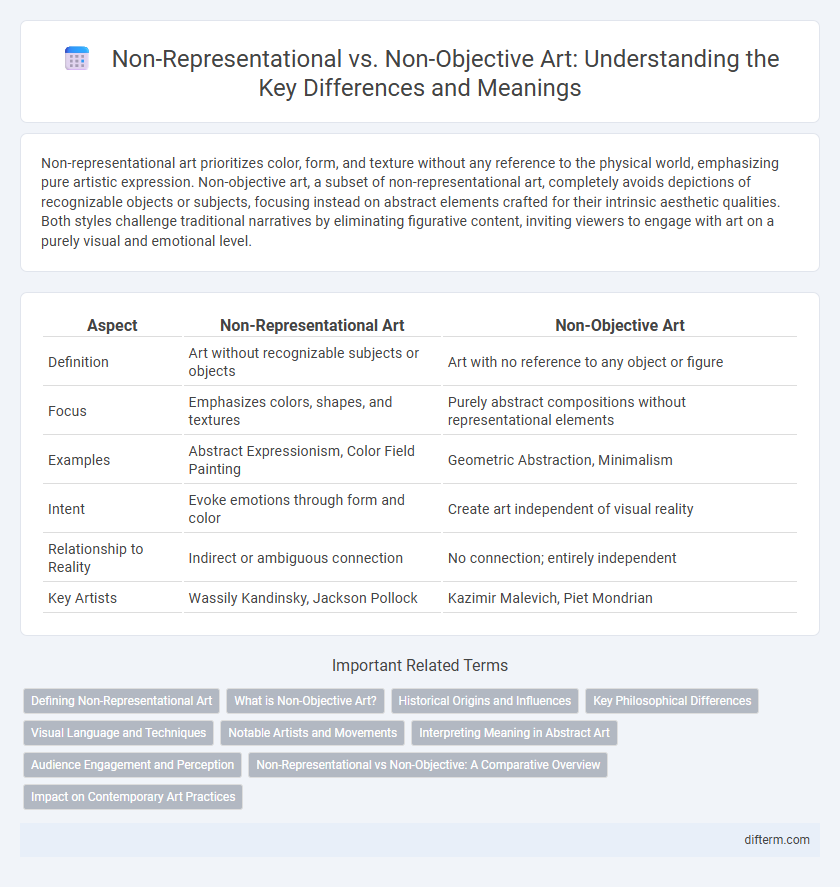Non-representational art prioritizes color, form, and texture without any reference to the physical world, emphasizing pure artistic expression. Non-objective art, a subset of non-representational art, completely avoids depictions of recognizable objects or subjects, focusing instead on abstract elements crafted for their intrinsic aesthetic qualities. Both styles challenge traditional narratives by eliminating figurative content, inviting viewers to engage with art on a purely visual and emotional level.
Table of Comparison
| Aspect | Non-Representational Art | Non-Objective Art |
|---|---|---|
| Definition | Art without recognizable subjects or objects | Art with no reference to any object or figure |
| Focus | Emphasizes colors, shapes, and textures | Purely abstract compositions without representational elements |
| Examples | Abstract Expressionism, Color Field Painting | Geometric Abstraction, Minimalism |
| Intent | Evoke emotions through form and color | Create art independent of visual reality |
| Relationship to Reality | Indirect or ambiguous connection | No connection; entirely independent |
| Key Artists | Wassily Kandinsky, Jackson Pollock | Kazimir Malevich, Piet Mondrian |
Defining Non-Representational Art
Non-representational art, also known as non-objective art, emphasizes visual elements such as color, shape, and texture without depicting recognizable objects or subjects. This art form prioritizes abstraction over representation, allowing artists to explore pure artistic expression independent of real-world references. Defining non-representational art involves understanding its roots in early 20th-century movements like Abstract Expressionism and its focus on evoking emotion and concept rather than illustrating concrete forms.
What is Non-Objective Art?
Non-objective art is a form of abstract art that does not depict recognizable objects or subjects, focusing instead on shapes, colors, and forms to convey meaning or emotion. It emphasizes pure visual elements and composition without reference to the external world, distinguishing it from non-representational art, which might abstract but still relates to real-world subjects. Pioneers like Wassily Kandinsky and Kazimir Malevich explored non-objective principles, creating works that prioritize aesthetic experience over narrative content.
Historical Origins and Influences
Non-representational art emerged in the early 20th century, influenced by movements such as Cubism and Futurism, emphasizing pure abstraction without referencing physical objects. Non-objective art, often linked to artists like Wassily Kandinsky and Kasimir Malevich, originated from the Russian avant-garde, focusing on compositions derived solely from shapes, colors, and forms without any symbolic meaning. Both movements challenged traditional representational art by prioritizing emotional expression and conceptual ideas over literal depiction.
Key Philosophical Differences
Non-representational art rejects any reference to the external visual world, emphasizing pure form, color, and line to evoke emotional or intellectual responses without depicting recognizable objects. Non-objective art also avoids representation but often focuses on the intrinsic aesthetic qualities of shapes and compositions as independent entities, asserting an existence separate from any physical reference. The key philosophical difference lies in non-representational art's emphasis on abstraction as a process of detaching from reality, while non-objective art centers on the autonomy of the artwork as a self-sufficient visual reality.
Visual Language and Techniques
Non-representational art embraces abstract visual language, emphasizing color, form, and texture without referencing recognizable objects, allowing artists to explore pure visual expression through techniques like gestural brushstrokes and dynamic composition. Non-objective art, a subset of abstract art, avoids any connection to real-world imagery entirely, focusing on geometric shapes, symmetry, and precise arrangements to create a visual experience grounded in design principles. Both styles utilize techniques such as layering, repetition, and contrast, but their conceptual focus diverges--non-representational art evokes emotion through spontaneity, while non-objective art highlights formal structure and visual harmony.
Notable Artists and Movements
Non-representational art, often linked to Abstract Expressionism, emphasizes spontaneous, gestural brushstrokes with notable artists like Jackson Pollock and Willem de Kooning shaping the movement. Non-objective art, rooted in movements such as Suprematism and De Stijl, focuses on geometric forms and color fields without referencing objects; pioneers include Kazimir Malevich and Piet Mondrian. These distinctions highlight how artists explored abstract concepts through different visual strategies, shaping the evolution of 20th-century art.
Interpreting Meaning in Abstract Art
Non-representational art lacks any reference to recognizable objects, focusing purely on elements like color, shape, and texture to evoke emotions and meanings independently of real-world visuals. Non-objective art similarly eschews identifiable subjects but often prioritizes deliberate composition and formal qualities to express conceptual ideas or inner experiences. Interpreting meaning in abstract art involves analyzing these visual elements and their interplay, allowing viewers to derive personal or contextual significance beyond literal representation.
Audience Engagement and Perception
Non-representational art emphasizes pure color, form, and texture without referencing real-world objects, fostering an open-ended experience that engages viewers through emotional and sensory responses. Non-objective art, while also abstract, often employs deliberate shapes and structures that evoke conceptual interpretations, encouraging audiences to explore meaning beyond literal representation. Both approaches challenge traditional perception, inviting viewers to interpret creativity through personal interaction and subjective understanding.
Non-Representational vs Non-Objective: A Comparative Overview
Non-representational art emphasizes pure abstraction, avoiding any reference to recognizable objects or subjects, focusing instead on elements like color, form, and texture. Non-objective art, a subset of non-representational art, completely rejects depicting any objects, often exploring geometric shapes and lines to convey meaning independently of real-world representation. The distinction lies in non-representational art including some abstracted elements derived from reality, whereas non-objective art is entirely free from any figurative or symbolic references.
Impact on Contemporary Art Practices
Non-representational art, characterized by the absence of recognizable subjects, emphasizes pure visual elements such as color, line, and form, profoundly impacting contemporary art by encouraging experimental and abstract practices. Non-objective art, which completely avoids reference to the external world, pushes artists to explore art's intrinsic properties, fostering innovative techniques and new media engagement. Both movements have expanded the boundaries of contemporary art, inspiring diverse expressions and challenging traditional notions of representation.
Non-representational vs Non-objective Infographic

 difterm.com
difterm.com